Feb 9, 2014 | coins, commentary, counterfeit, policy
A persistent question that follows stories about counterfeiting is why do most of the counterfeits come from China and why do they get away with doing this? Unfortunately, the answer lies in differences in our laws, politics, and cultures that may not be as easily resolved as people would like. However, understanding the issues may make it easier to understand how to resolve the problems.
The easiest part of the explanation is the legal standpoint of what we see as counterfeiting versus what the Chinese legal system sees as ordinary commerce. In the United States, every coin ever minted is still legal tender and legally an instrument of the government. Although the Trade dollar was demonetized in 1876, it was remonetized as part of the Coinage Act of 1965 making it legal tender (31 U.S.C. § 5103) for trade in the United States. Even when the United States changes the design of a coin, it remains legal tender.
To protect its currency, the United States has anti-counterfeiting laws that say it is illegal to counterfeit the nation’s money and use in commerce. To protect the collection of collectible coins and currency, the United States created the Hobby Protection Act (15 U.S.C. § 2101 et. seq.) to protect the money supply when it is a collectible and not an instrument of commerce.
In the United States, laws a cumulative. Once passed, they remain the law until repealed or declared unconstitutional by the courts. This is not the way in many other countries. When a new government takes power they are given the authority to rewrite the laws in some form. Not only does this happen with authoritarian governments but in most parliamentary democracies. While new parliamentary governments have restrictions on the changes they make, authoritarian governments do not.
The People’s Republic of China has been run by the Communist Party since 1949. Their rules and laws were changed with the rise of Chairman Mao Zedong and get altered by the party every time a new chairman takes over the party. This includes the control over the money supply. Thus, when the Communist Party took over the country, they demonetized the money produced by the Republic of China and issued renminbi, the “people’s currency.”
In real terms, all coins struck since 1955, the first issued under the current government, are legal tender. Currency printed since 1999, the fifth series are the only legal tender notes. Any other coin or currency note has been demonetized.
Under Chinese anti-counterfeiting laws, it is illegal to duplicate any legal tender coin or currency note for any reason. However, since coinage from previous regimes is no longer legal tender, it is legal strike coins with designs that are no longer legal tender. Chinese laws do not recognize the collection of these coins as a market to protect. Coins are an instrument to facilitate commerce.
Buying and selling coins as an object is just a matter of commerce between individuals under Chinese law and not something that requires protection. While the Chinese buyer can use the obsolete coin as an object of barter, bartering does not hold the same legal status as paying with legal tender currency. Basically, once it is demonetized for new coinage, just about anything goes.
Unlike United States law Chinese law does not recognize the perpetual legal tender status of every coin issued. Chinese law also recognizes that counterfeiting current issues of other countries is also illegal because someone could try to use the coin in commerce where it is legal to use foreign currency. This means that in China, it would be illegal to reproduce a presidential dollar or Washington quarter, but producing Morgan dollars or a set of 1921 Walking Liberty half-dollars is legal in China because these are coins no longer issued in the United States.
When China is asked to assist the United States to stop the counterfeiting of coins, China does not recognize that its people are doing anything wrong. The coins are no longer being made, they are not in circulation, and their laws allow people to make copies of these coins. China does not recognize a collectible coin market. In fact, the only laws they have regarding collectibles are laws protecting antiquities and cultural properties. Under Chinese law, you cannot duplicate the proverbial Ming Dynasty vase and try to pass it off as real but it is legal to reproduce a Rembrandt masterpiece since he is not Chinese and his work was not made in China.
A trade attorney that was consulted for this article confirmed that when it comes to these issues, Chinese law is very protectionist. The claim is that they follow their laws consistently regardless of outside circumstances and they refuse to make exceptions citing the complication with enforcing their laws in a country with a population of more than 1.3 billion people.
Making the problem more difficult, copying and counterfeiting of grading service holders is not covered by Chinese law because they are not government entities. The grading services would have to fight the counterfeiters using Chinese patent and copyright law. A patent attorney confirmed that not only would this not stop the problem, but foreign challenges to alleged patent and copyright violations are rarely successful in Chinese courts.
The Chinese government has no incentive to help the United States or any other country fight counterfeiting in what is perceived by the Chinese as a small market problem. To put the resources necessary into what looks like a petty crime for selling inexpensive, non-circulating duplicate coins that are within Chinese law to manufacture is not worth their resources.
While there is anecdotal evidence that the Chinese government knows about the counterfeit trades and some officials informally support the efforts because they get kickbacks, official Chinese policy denies everything.
A lot has been written about the nature of the relationship between the United States and China since President Richard Nixon’s trip to China in 1972. Neither side trusts each other nor does neither side believe each other. Today, the United States decries the Chinese for buying too much of our debt, allegations of spying, industrial espionage, and cybercrimes. The Chinese say that the United States is trying to bully the world and that these naysayers are making up the stories to scare the world into following them. The United States talks about civil rights violations within Chinese border and the Chinese government tells the United States to mind its own business.
The greater opening of markets between the country and the increase in popularity of bullion coins has made the Chinese Panda a popular coin amongst collectors and investors. Those of us who buy these coins know that even with the production increases since 2010 new issues continue to command a premium greater than other bullion coins.
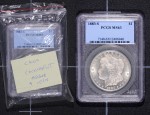
PCGS representatives showed Congressmen counterfeit U.S. coins in counterfeit PCGS holders during their recent meetings in Washington, DC. (Photo courtesy of PCGS.)
These are the values of the Chinese government. Whether you agree with them or not, Communist Party officials will resent anyone telling them how to manage their domestic affairs. They want advice about how to treat their citizens as much as the United States wants similar advice from China.
All things considered, there is no incentive for China to stop the manufacture of counterfeit collectable coins.
It is not against Chinese law for these people to manufacture coins that are no longer in production. Chinese people who are manufacturing these coins are working in China and many employ other people. It means there are fewer people on what little government assistance the Chinese government provides and they can collect taxes on the incomes.
When a United States trade representatives negotiate with their Chinese counterparts, it gives the Chinese a chance to lecture the United States how they resolved the counterfeiting issues which leads to a discussion on currency handling and management, which is a sore subject in the United States since the United States questions Chinese monetary policies.
Finally, it gives China a measure of moral superiority against the United States. After all, China figured out a way to prevent the impact of counterfeiting of older currency, why can’t the United States do the same?
China has no incentive to help the United States to solve a problem that they perceive does not exist. It is up to the United States to resolve these issues. This is why the industry needs the Collectible Coin Protection Act (H.R. 2754) to allow law enforcement to cut off the supply lines from the counterfeit manufacturers in the United States.
Feb 6, 2014 | bullion, coins, commentary, counterfeit
Of all the threats to the numismatics industry one stands out as being the biggest threat: counterfeiting. While thefts and violence of dealers are tragedies, the theft is more localized and easier to deal with because, for the most part, criminals are stupid and leave evidence. Also, since the dealer community is small and there is cooperation from the pawn industry, there is a higher resolution from thefts than expected.
Counterfeiting is worse. Counterfeiting can be a systemic problem that infects the industry in the same way a virus infects your body. To extend the analogy, thefts would be like breaking a finger. It will hurt and cause problems, but the rest of the body will survive. A virus hurts the entire body.
A counterfeit coin is added to the market and is sold to an unsuspecting buyer. The buyer figures out that the coin is counterfeit and is usually embarrassed to admit their mistake. Rather than report the crime or just chalk it up to bad luck, they try to resell the coin, even at a loss, to make up some of the money. The buyer, who is now the reseller, can plead ignorance by claiming buyer’s remorse and say that they decided they did not want the coin.
Overseas counterfeiters, mostly from China, also setup broker networks where they sell their creations to United States-based sellers for them to sell to unsuspecting buyers. While many use online sources to sell these counterfeits, many will try to sell them to low-end coin shops, bullion traders like the ones who setup in hotel rooms, and pawn shops. Unfortunately, they are successful in selling of these items to what should be trusted dealers keeping them in hobby circulation like a virus coursing through your veins.
The problem is not limited to raw coins. Counterfeiters have figured out ways to counterfeiting both the NGC and PCGS holders along with their holographs and seals in order to fool potential customers. Since both companies make it easy to look up serial numbers via their websites, counterfeiters will use the serial number of a real coin and counterfeit that coin for the holder. Both NGC and PCGS have been doing as much as technology allows when upgrading their holders and holographic seals to thwart counterfeiters.
A reminder of the issue landed in Inboxes today from Doug Davis of the Numismatic Crime Information Center. Rather than describe the warning, here it is in its entirety:
COUNTERFEIT SUSPECT
Dealers in Illinois, Missouri, Oklahoma and Kansas should be on the look out for a suspect selling counterfeit coins and bullion within the last ten days. The suspect has been identified as Gabe Owen and sometimes uses the alias Garet or Gabriel Owen. Owen is a white male and uses a Kansas driver’s license or a passport as identification. The vehicle driven by Owen is a white Yukon or Tahoe.
Owen is attempting to sell gold bars, one ounce gold eagles, a 1795 PCGS VF dollar and silver eagles. The same suspect was identified in similar incidents and reported by NCIC approximately one year ago.
We are working with authorities to get a current photo. At the present time there is no outstanding warrant for this subject.
A basic tool against counterfeiting is education. You should know and understand what you are buying. While this sounds basic, you have to think about the coins you are purchasing. For example, collectors of Morgan dollars might think they know what the coin looks like and what to look for, but do you really know? Could that variation in the strike be a known variety, known as VAMs after ground breaking research into Morgan dollar die varieties by Leroy C. Van Allen and A. George Mallis? What if it is a real Morgan dollar that was once cleaned or tooled that would be at least worth its value in silver?
Even if you do not have the education give a definitive answer, how many times have you heard the target of a scam say that something did not seem right or that they questioned a lot of what the seller was saying? More times than not, these instincts are usually right and the few times they are not right, you should feel better knowing that at least you had the sense to listen to that inner voice because you might need it next time.
Always remember, if the deal is too good to be true, it probably is not a good deal!
While counterfeiting is illegal and there are protections under the Hobby Protection Act, the only person that can be prosecuted is the seller. Under the law, the only other person who could be prosecuted is the manufacturer. In most cases, the manufacturer is outside of the United States and beyond the reach of law enforcement.
One tool that can help is H.R. 2754, the Collectible Coin Protection Act. The Collectible Coin Protection Act updates the Hobby Protection Act by allowing law enforcement to target the distributors as well as the sellers. By making the changes H.R. 2754 prescribes, it allows law enforcement to cut off the supply lines from the counterfeit manufacturers.
H.R. 2754 passed the House of Representatives on July 30, 2013 and was sent to Senate for their consideration. However, the bill is sitting in the Senate Commerce, Science, and Transportation waiting to be scheduled. Even if your senators are not a member of this committee, if they hear from constituents that this is a concern, they will speak with the committee chairman Sen. Jay Rockefeller (D-WV) or the ranking member Sen. John Thune (R-SD) to bring this to a vote.
Be part of the antidote to this virus and go to senate.gov, use the pull down menu in the upper-right corner of the page to select the state you live or work. Please contact both of your senators and let them know that you support the Collectible Coin Protection Act. When you contact your senators, tell them that the bill is revenue neutral. It will not add to the deficit and will not require additional appropriations.
In the meantime, please be careful and educate yourself before making that purchase. Buy the book before you buy the coin may be more important now than ever.
The advantage is that almost any book at almost any price is a bargain. You cannot buy them much cheaper. The profits come from knowing what is between the covers. The best collections are built on knowledge, not price sheets.
I could not have said it better!
Jan 29, 2014 | ANA, books, commentary, technology
Since learning to program computers in 1976, I have been a proponent of technology and its positive effects on the progresses we have made in many areas of our lives. This technology has progressed things we can see like the automated teller machine, quicker checkouts at the grocery stores, smartphones, tablets, and even all the gizmos in your car. If I look at the iPhone in my pocket and compared it to the Poly 88 that I first programmed or the IBM 360 that I submitted punch cards to, it would be like trying to compare a Roman Denarius to an American Silver Eagle.

For those not olde enough to remember, this is a computer punch card!
I love what technology has done to enhance many aspects of our lives. And you do not have to be a user of technology to have it affect the way you live. Computers help with inventory control to ensure store shelves are stocked; manage traffic control both in the air and on the ground; and generally make the behind-the-scenes management of a lot of things easier including maintenance on this blog.
Since my response to Dennis Tucker, Publisher of Whitman Publishing LLC, I have received a mix of private email notes about one phrase: calling physical books ‘Dead Tree Editions.” In the first two hours after the post appeared, I received more than two-dozen email notes running slightly in favor of physical books. As of Wednesday afternoon, the score was 17-15 in favor of real paper.
I do not know the demographics of those who did not volunteer the information, but based on the comments like, “I have been collecting for umpteen years…” or “I was a teenager when clad coins were just beginning…” it does not take much to get a general idea of demographics.
Of the 17 who responded that they prefer paper books over e-book, I am guessing that 12 are like me, members of the AARP demographic (50 and over).
However, contrary to what some have written, I am not a techno-snob!

Scott’s 1974 Plymouth Gold Duster. No computers in this baby!!
For more images of this car, click here.
My complaint is not with the preference but the availability of e-books that will allow me and everyone else to choose. I understand the need for choice because neither Whitman nor I will convince everyone to only read e-books.
However, if you look at the demographics of the ANA and its future, the next generation that are its future members, the so-called Generation X people, is the first generation of significant technology adapters and e-book readers. Gen X’ers are the first big wave of technology adapters who know of a connected world and have a vague memory of a world before Al Gore invented the Internet.
Right behind Generation X are the Millennials who grew up with the explosion of the Internet and probably have never read a newspaper cover-to-cover. While hobby publishers may have some time adjusting with Generation X, they will lose completely to the Millennials if they do not adapt.
Whitman is not the only publisher that needs to better examine its use of technology. Krause Publications is not much better. Where Whitman lacks in vision, Krasue lacks in execution. Rather than embrace electronic publishing that is friendly to e-readers, Krause and F+W Media, its parent, is holding onto the old-style by offering its products using Portable Document Format (PDF) rather than using formats that are friendlier to e-readers.
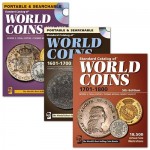
Standard Catalog of World Coins CD set covering 1601-1900
Even the venerable Numismatic News has stuck its publishing toe in the e-publishing waters by making one edition electronic. However, instead of embracing the newsstand formats that would be friendly to an iPad or Kindle e-reader, they are mailing PDF layouts of this publication. I hope you have plenty of space in your Inbox.
In the meantime, the American Numismatic Association is producing an e-reader friendly version of The Numismatist that is far easier to read than the PDF edition of Numismatic News emailed monthly. Since The Numismatist reader app works well, I stopped receiving the paper edition of The Numismatist opting for a Basic membership and to read the journal electronically. I do not miss the “Dead Tree Edition.”
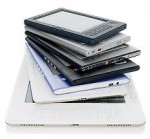 It is not a demographic issue as it is a commitment to the hobby’s future. I am sure the people at Hemming’s Motor News have a similar problem with demographics as those faced by Whitman and F+W. If you read their publications, you will notice that their demographic skews to an older population. Yet, they have quietly embraced the technologies that some of their readers want while still publishing physical magazines. I recently subscribed to the digital version of Hemming’s Classic Car on my iPad and love it!
It is not a demographic issue as it is a commitment to the hobby’s future. I am sure the people at Hemming’s Motor News have a similar problem with demographics as those faced by Whitman and F+W. If you read their publications, you will notice that their demographic skews to an older population. Yet, they have quietly embraced the technologies that some of their readers want while still publishing physical magazines. I recently subscribed to the digital version of Hemming’s Classic Car on my iPad and love it!
How could Hemming’s do this for the auto enthusiasts market but Whitman and F+W cannot do the same for numismatics?
Whitman and F+W have shown that they cannot be relied upon to be the leaders in producing the numismatic information in a way the future of the hobby will embrace. Since other markets have proven that it is possible to embrace technology to enhance the physical world, I can only emphasis my commitment to help the ANA build a better technology infrastructure because if we leave it to the market, they will fail the hobby.
Jan 28, 2014 | ANA, books, commentary, technology, web
In letter to the editor that will appear in the February 10, 2014 edition of Coin World (now available online), Dennis Tucker writes that the target of the American Numismatic Association website rebuild and acknowledging “’Young Numismatists are the future of the hobby’ are slogans to murmur approvingly, without logical reasoning.” He goes on to give his view of the market to target without recognizing facts of market forces.
For the record, Dennis Tucker is the publisher of Whitman Publishing, LLC whose books are widely read in the hobby. Whitman Expo, a division of Whitman Publishing, runs probably the three largest commercial numismatics shows in the country out of Baltimore.
Tucker, whose business is selling physical books, or what I would call “dead tree editions,” opines that it would be wiser and more productive to target those in the 50 and 60 year old demographic than 10 and 20 year olds. It is obvious that Tucker is looking at the issue from the spectrum of the business he is responsible for rather than the real future.
One problem with Tucker’s argument is similar to those in many other hobbies that rely on the collecting of physical objects: if the hobby cannot be translated to the younger demographic then the future of the hobby will be lost. As the final wave of the baby boomer generation celebrates their 50th birthday this year, empty chairs are becoming more prominent at meetings with fewer standing there to fill those chairs. There seems to be a smaller pool of people ready to join even though the population in the demographic that Tucker wants to target has grown.
Another problem with his argument is that it does not address how to reach this or any other demographic. Based on his company’s business model and his letter, Tucker is implying that even his target demographic is not using technology and cannot be reached using technology. Unfortunately, that flies in the face of researched facts.
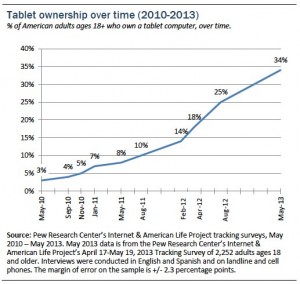
Pew Internet and Lifestyle Study: For the first time, a third of American adults own tablet computers
Using tablets as a barometer, we can look at the “Tablet Ownership 2013” report from the Pew Internet and American Life Project. In their study, Pew reports that through May 2013, tablet ownership has grown from May 2010, one month after the iPad’s introduction, the number of tablet users have increased from 3-percent to 34-percent. That is more than an 1100-percent increase in three years!
Further, Pew’s research found that the demographic with the most significant ownership are the age group of 45-54 with 38-percent ownership and 35-44 with 49-percent. The first is part of the market that Tucker wants to target while the latter is the market that should be next.
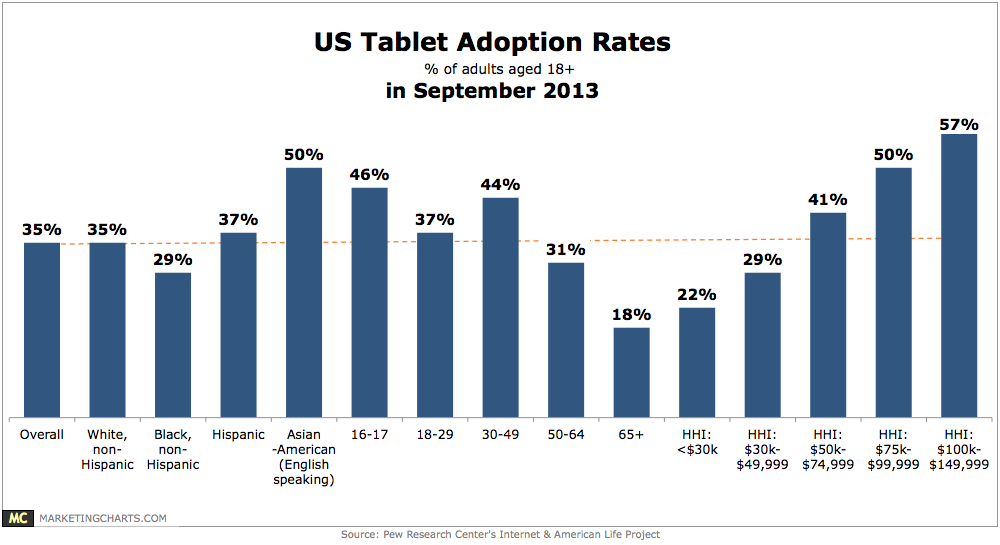
US Tablet Owner Demographics as of September 2013 (courtesy of marketcharts.com)
Pew’s research also looked at tablet ownership by income and found that 56-percent of adults that own tablets earn $75,000 or more per year. If Tucker’s goal is to target those with disposable income, just look at one of the fastest growing area of technology to understand where the markets are going.
Another study recently release by Pew notes that e-book readership has grown as the sales of e-readers have risen. While the study does not say people have not completely replaced their dead tree versions with electronic editions, there is anecdotal evidence that if more titles were available electronically, those with e-readers would take advantage of that.
In a broader look at the emerging online world, Pew Research provides trend data that shows that more people are using the technology in their daily lives. Not only are more than 60-percent of the 50-64 year old demographic using the Internet and associated technologies a large numbers, but e-reader ownership is increasing. It is also increasing in the younger demographics, including those in the 30-49 year old range who would be Tucker’s next generation of customers.
The ANA, like any business, has to adapt to new markets or they lose their relevancy. It is not enough to say to target one group over the other but you have to target the markets where they are moving. Even if the business is concentrated in one market, it has to adapt and diversify within its market or it becomes irrelevant. As a stark example, you can look at the downfall of Blackberry. Once the king of the smartphone, Blackberry, once called the Crackberry because its users were addicted to it like a crack addict was addicted to crack-cocaine, went from the most popular phone to the least popular phone because they ignored the trend set first by Apple then by Google’s Android.

Borders, a one-time success story, did not adapt to the changing market and paid for that failure.
Whitman and Tucker could help the ANA by looking at this future and target their books to this growing demographic. While the quality of Whitman’s books have improved, the companies selling tablets and e-readers are reporting increased sales of their products and an increased sales of content for those products.
Amazon is betting a lot on the tablet and e-reader market. They sell the Kindle nearly at their cost in order to lure customers into their dedicated markets. Amazon hopes to sell you a Kindle so that you buy their e-content which they make money by transferring bits. Not only has Amazon built in the infrastructure to transfer bits of information, but they are selling it as a service to others in order to reach the same markets. Amazon is betting that once you are in their market, they can sell you these bits, which are cheaper to store, package, and ship than dead tree edition books.
While the e-book market is growing, Whitman and other hobby publications are dipping their proverbial toes in this market. Although Whitman does offer a number of its books in e-reader format, they do not market that fact nor do they do any outreach in order to build that market. It is as if they publish this content so that when the topic comes up they could say that they do have e-books. They are checking the box, so to speak.
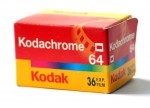
Kodachrome; You give us those nice bright colors; You give us the greens of summers; Makes you think all the world's a sunny day, oh yeah!
Growing the ANA is like growing a business; you have to look at what your target market’s demographics are and figure out how to reach them. For hobbies like numismatics, the new target is online where the current generation is moving and where the next few generations will be. Not adapting to those new markets can make both the ANA and Whitman as relevant as the Betamax and go the way of Woolworth’s or Pets.com.
I am glad the ANA is doing something to expand its market.
Trend chart courtesy of the Pew Internet and American Life Project
Data chart of the Pew Research courtesy of
marketcharts.comImage of Borders closing is courtesy of
PennLive.com.
Kodachrome box image courtesy of
Wikipedia.
Kodachrome lyrics (image caption) by Paul Simon
Jan 24, 2014 | advice, coins, commentary
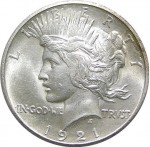 If you have not read “Hobby Must Fill the ‘Empty Chair’” that Michael S. Turini wrote a few weeks ago, then click here to read it first. Go ahead, I’ll wait.
If you have not read “Hobby Must Fill the ‘Empty Chair’” that Michael S. Turini wrote a few weeks ago, then click here to read it first. Go ahead, I’ll wait.
How do we fill the empty chair?
After years of growth spurned by the 50 State Quarters program, the hobby seems to have plateaued at levels lower than expected. Explanations for the slowing in the hobby’s growth range from the downturn in the economy through the downturn in confidence of the products being produced by the U.S. Mint.
I think Michael Turini stumbled on the problem: those of us most interested are getting old.
Not only are we getting old, but we are not doing what it takes to make numismatics inviting to younger members.
We seem to do pretty well in attracting young numismatists (YN), those under 18 years old. In fact, there are programs that actively recruit YNs for the hobby. But we are not doing enough. Not only are there no programs to keep YNs interested after they stop being YNs, there is a real lack of diversity in the hobby.
During my recent trip to Orlando for the 2014 FUN Show, I noticed that there were an increased number of women than I have seen at other shows. I also noticed that other minorities were attracted to the show. Seeing this was great, but how can it be spread to more areas of the hobby?
Numismatics can be a fascinating look at our history. The money that was used reflects the economy of the time which can tell a great story. What can the Morgan dollar teach us about the history of silver, the economy, and the politics of the time that could interest someone? Would learning about the ‘Crime of ’73’ make people think differently about the impact of politics on our economy?
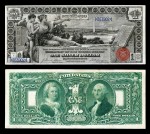
“History Instructing Youth” Educational Series $1 Silver Certificate, Series 1898,
Our thoughts may also be too old.
There are great stories in other areas of numismatics beyond coins and currency. So-called dollars, tokens and medals the size of a dollar coin, were struck to commemorate something, some event, dedication, or anything of significance. So-called dollars tell stories that coin cannot and yet does not get the same attention in the numismatic press as coins.
If you are looking for new numismatic areas to explore or to use as a source to educate someone about history using numismatics, what about items like trade tokens or tax tokens? Trade and tax tokens were local currencies used to build business. In many ways, trade tokens could be considered coupons before someone issued paper coupons!
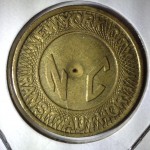
New York City Type 2 Subway Token error. It’s missing the punched out “Y”
In Canada, there are collectors who collect the interesting coupons from a particular tire company.
I know a European-based collector who collects communion medals from a particular region because it traces the history of Catholicism in the area where his family has lived for centuries.
You can even collect the coins of the country where your ancestors or other members of your family are from. I became interested in Canadian coins since my wife’s family is from Canada. Now I am looking at the large cents produced during Queen Victoria’s reign which are affectionately called ‘Vickie Cents.’
Numismatics does not have to be about plugging coins into the holes of a folder or album. It does not have to be about buying coins encased in plastic holders with high numbers or extra symbols. Use numismatics to learn about your past. You can learn more about yourself by understanding your past and what better way to understand your ancestral past than to collect something from that era.
Go collect something new and make sure you tell people about your finds. Tell someone the interesting stories of the past using numismatics as the prop. Make sure you tell them they can have fun with this, as well. Then invite them to your next club meeting and make sure someone is there to talk about their finds and history.
It is only when we can move beyond the cold metal and paper to make the stories interesting can we think about filling all of the empty chairs in the room.
Jan 16, 2014 | ANA, commentary, news, shows
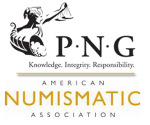 According to a press release issued on January 15, 2014, the Professional Numismatists Guild and the American Numismatic Association will jointly host “the first” PNG-ANA Numismatic Trade Show the weekend prior to the 2014 World’s Fair of Money in Rosemont that will be open to the public.
According to a press release issued on January 15, 2014, the Professional Numismatists Guild and the American Numismatic Association will jointly host “the first” PNG-ANA Numismatic Trade Show the weekend prior to the 2014 World’s Fair of Money in Rosemont that will be open to the public.
The PNG-ANA Numismatic Trade Show will be Saturday through Monday, August 2-4, 2014. The World’s Fair of Money will be held Tuesday, August 5 through Friday, August 9, 2014.
Doing this eliminates PNG Day(s) prior to the World’s Fair of Money and will extend the entire show week to eight days.
It was my understanding the PNG Day was for PNG members to buy and trade amongst themselves to prepare inventory for future sales. Inventories were bolstered by wholesale dealers or dealers who would rather sell to other dealers rather than staff a table at the World’s Fair of Money. While it was closed to the public, it was possible to either buy your way into the PNG show or get an invitation from a PNG member dealer.
What may have been the driver of this decision is that it was getting easier to obtain an invitation from a PNG dealer. Citizens of some of the popular coin forums would be able to download an invitation posted by member dealers to use for PNG day. A friend who attended PNG Day in 2013 said that non-members clearly outnumbered members by a large margin.
Where I question the decision is that it makes the show eight days long—emphasis on long. While some dealers will not attend both shows, there are many dealers who will be there all week. Those of us who are buyers know that some dealers can get surly toward the end of a show like the World’s Fair of Money. Can you imagine how prickly these dealers will be by August 8?
With the show ending on a Friday, a day that will attract local attendees, will the long show, cranky dealers, and the inevitable empty tables turn the World’s Fair of Money into a bad showing for the ANA?
As part of the PNG-ANA show, there will be a daily give away of a Double Eagle gold coin that will be donated by a PNG member dealer. There will also be an auction by Stacks-Bowers Galleries.
There will be no similar give away for the World’s Fair of Money. Both Stacks-Bowers and Heritage Auctions will combine to be the official auction of the World’s Fair of Money.
Since Numismatic Guarantee Corporation is the official grading service of both organizations, they will be present for the entire week. Good luck keeping staff motivated!
This decision brings back the concept of a pre-show that was discontinued because it was poorly attended and made the week too long. It also has the possibility of up staging the ANA and the World’s Fair of Money.
Since most collectors work people outside of the numismatics industry and Rosemont is not exactly a destination location for families, this will increase the attendance during the weekend of the ANA-PNG show rather than during the week for what should be the premier show, the World’s Fair of Money. Casual collectors who have to arrange for travel and time off from work will be more attracted to the co-branded show on the weekend rather than the ANA show.
The ANA should not give up its premier status to share the stage with PNG.
While the ANA should work with PNG and other organizations, the ANA should not play second fiddle to any other organization regardless of the organization. If the ANA wants to be the premier numismatic organization, the one that anyone wanting to learn about and be about numismatics, this type of partnership that has been clearly driven by PNG is not the right way to be premier.
This is a bad decision for and by the ANA.
Jan 8, 2014 | coins, commentary, Eagles, news, other
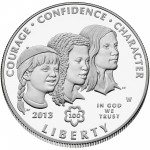
2013 Girl Scouts of the USA Centennial commemorative coin
Following the close of the year, the U.S. Mint told Coin World that the sales of the 2013-W Girl Scouts of the USA Centennial Commemorative coins was so low that it did not cover the costs of the program as required by law. U.S. Mint records show that 86,354 proof and 37,463 uncirculated coins were sold for a total of 123,817 coins. That is a little more than 35-percent of the 350,000 authorized by the law.
Sales of the 2013-W Girl Scouts of the USA Centennial Commemorative coins was to have ended on December 17, 2013 but the U.S. Mint extended the sale through December 31, 2013. By law, a commemorative coin can only be sold in the year it was struck.
The U.S. Mint cannot be faulted for this lack of interest. Information about the coin had been a fixture of the front page of the U.S. Mint’s website. Their information included a video introduction by United States Treasurer Rosie Rios and provided information in its various outreach programs. The U.S. Mint is limited on the type of advertising it is allowed to use.
Usually, the burden of advertising falls to the organization that would most benefit from the sale of the commemorative coin. Since I do not have a connection with Girl Scouts of the USA, I cannot report on their promotional experience.
This news is both sad and troubling. Although there are collectors who will buy the coin to be part of their commemorative collection, the real success or failure of a commemorative coin is based on its subject. For whatever reasons, the Girl Scouts was not a popular subject.
When a commemorative is made for an organization, purchasers want some affinity for the organization. Unless you are a collector, you are not going to buy a coin honoring that organization, especially when the price is over $50 during a recovering economy. I wonder if a clad half-dollar may have been a better idea?
While having a program to honor the centennial of the Girl Scouts of the U.S.A. was a laudable idea, maybe it was not a good one. It was a coin with a limited appeal and those in the target audience did not respond.
It is also troubling that the Girl Scouts were not able to generate more sales on its own. In coming up over 31,000 coins short of being able to receive the payout, it is time to question the diversity of the hobby—again.
Numismatics is dominated by middle-aged to older white males. While there is an outreach to young numismatists, those programs appear to succeed in recruiting mostly white boys and keeping them interested until they become 18 years old.
Consequently, there appears to be no concentration on providing opportunities to young girls and minorities. While the Boy Scouts provide one outlet, local experience shows that those troops are dominated by young white males. Surely there are girls and minorities interested in numismatics. If not, why not?
If anyone missed the point, the executive directors of the American Numismatic Association and Industry Council for Tangible Assets (ICTA) are women. I do not believe either have their jobs because they are women. They are qualified people leading an industry that happens to male dominated.
There has to be a way to appeal to the demographics that are not being represented in the hobby. Aside from women and minorities, the hobby has to figure out how to engage those older than young numismatist (YN) but younger than middle-age. There has to be a way to keep them interested if they started as a YN or grab their interest before middle age. In 2011 I addressed these issues calling potential members the “Lost Demographic.” There have been little changes since.
What will it take to expand the hobby to all sectors of society? Please feel free to let me know in the comments section below. We can all work together for the betterment of the hobby!
Jan 3, 2014 | coin design, coins, commemorative, commentary, COTY
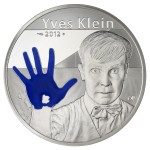
Monnaie de Paris 2012 Yves Klein commemorative was named 2014 Coin of the Year

2011 Commemorative celebrating the 100th anniversary of the Royal Dutch Mint’s facilities with QR code on reverse
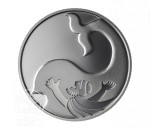
2010 Jonah In The Whale 2-New Sheqalim coin from Israel

2009 White Rhinoceros 100 Rand gold coin from South Africa
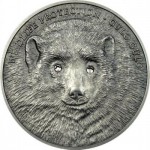
2008 Mongolia Wolverine with diamonds for eyes
Three of the last five COTY winners had design elements that were not based on the sculpture of the coin but on a design gimmick. Were these the best designs or did the gimmick influence the voting?
I have asked before whether it is wrong to include other design elements on a coin, especially non-circulating legal tender (NCLT) coins. When I ask these questions, I bring out the picture of my Somalia motorcycle or muscle car coins. I also like the Canadian 2006 Breast Cancer silver commemorative coin and the special 25-cent circulating coin the Royal Canadian Mint produced. These were not overt uses of color but almost an enhancement to emphasize the pink ribbons on the coins.
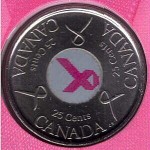
2006 Breast Cancer Quarter was Canada’s first colored circulating coin
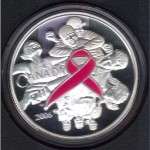
2006 Breast Cancer Silver Coin with colored pink ribbon.
But is it too much of a gimmick? After the RCM produced those coins it seems that they dove in face first into producing colored coins. It also seems that the rest of the world also has been spending its time printing coins and not minting them (see the New Zealand Mint). Although I am guilty of buying into this type of design concept, there comes a time when the concept has gone too far. In television the concept is called “Jumping the Shark.”
While others are printing coins, the Royal Mint is coming up with designs that are interesting sculptures. In fact, if you go to their website and look at their offerings you will find that the Royal Mint has nice designs, interesting packaging, but no color. Although their artists take advantage of the design elements using bi-metallic coins, they are sculptured arts and not printed designs.
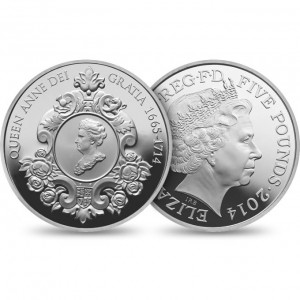
2014 £5 crown commemorating the 300th anniversary of the death of Queen Anne
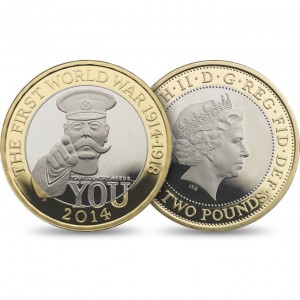
2014 £2 coin commemorating the 100 year anniversary of the start of World War I
U.S. coin designs have had the best designs over the last few years. However, the introduction of the “enhanced uncirculated” coins with the selective frosting has opened up new ways of enhancing sculpture elements on coins. It would be interesting to see what the U.S. Mint artists can do if given the free hand to design coins and using the laser to enhance the design.
Given the recent history of the COTY competition, the 2014 National Baseball Hall of Fame commemorative coin is almost a shoo-in for 2016 COTY honors. While the elements will be sculpted rather than printed and the curved planchet will be interesting, it is probably enough of a gimmick to sway the World Coin News confab when it meets to discuss the 2014 coin in December 2015.
As an aside, why do we have to wait a year for the COTY competition? With technology what it is today, why does it take a year to do the COTY competition? If the award is given in February, then why select the COTY in December or January? Does it really make sense for the 2014 COTY to be coins date 2012? Why not call it the 2012 COTY since the coins are dated 2012 and award them at the beginning of 2013—or in this case, the 2013 COTY being awarded in 2014?
The one year delay might have made sense when mail delivery was less reliable and information was delayed by the speed of the teletype and the printing press. In the information age where 2012 is not only yesterday’s news it is ancient history, it is time for Krause Publications and World Coin News to modernize their process and come up with something a little quicker than a one year delay.
Image Credits
- 2012 Yves Klein commemorative courtesy of the Monnaie de Paris.
- 2011 Royal Dutch Mint commemorative with QR code courtesy of the Royal Dutch Mint.
- 2010 Jonah in the Whale commemorative courtesy of the Israel Coins & Medals Corp.
- 2009 White Rhinoceros 100 Rand gold coin courtesy of Krause Publications.
- 2008 Mongolia Wolverine coin courtesy of the Wolverine Foundation.
- 2014 British coin images courtesy of the Royal Mint.
Dec 28, 2013 | ANA, Baltimore, commentary, other, shows
In a move that continues to be unexplained for reasons to be rumored to be grounded in personal issues rather than sound reason, American Numismatic Association Executive Director Jeff Shevlin was fired by the Board of Governors. Based on both public and not so public information regarding this firing, I believe that the ANA Board of Governors made a colossal mistake that proves that the Board is not up to the task of properly running the organization.

ANA Executive Director Kimberly Kiick
In a move to try to avoid controversy at the National Money Show in May, the Board rushed in to appoint longtime employee Kim Kiick as Executive Director. While her past experiences with the ANA questions as to whether the ANA made the best choice, her performance since her appointment shows that my opinion could be proven wrong. Time will tell.

Kathy McFadden, Executive Director of the Industry Council for Tangible Assets
Moving forward, Kathy McFadden was hired as Executive Director. McFadden has spent 18 years leading two different region associations of mechanical contractors with experience in legislative advocacy, public education, finances, public relations, etc. I had met McFadden for all of two-minutes at the Whitman Expo in November and look forward to working with her in my role with the Gold & Silver Political Action Committee.

David Crenshaw, Chief Operating Office of the Industry Council for Tangible Assets
Crenshaw leaves a good property for Lori Kraft who was named the Expo’s new general manager by Whitman.
The ANA’s changes were shrouded with turmoil and the ICTA changes are a celebration for an organization that is thriving. Certainly an interesting juxtaposition.
Dec 25, 2013 | base metals, cents, coins, commentary, dollar, Federal Reserve, gold, history, Morgan, Peace, silver, US Mint
Two discussions that transcended numismatics is what to do about the one dollar coin and common one-cent coin. Both coins cause different problems depending on who is doing the arguing. I find it amazing that the logic that is used to support the argument is not used consistently.
Dollar coins have been around since the beginning of the republic. In fact, the coin that currently holds the record for being the most expensive coin sold at auction is a 1794 Flowing Hair dollar. The coin is reported to be amongst the first dollar coins minted at the newly created Mint was bought by Legend Numismatics for more than $10 million. Laura Sperber, one of the principals of Legend Numismatics, was quoted as saying that she was prepared to bid higher for the coin.
If that is not enough to show how important the dollar coin has been in our history, there is always the 1804 Bust dollar, also known as “The King of Coins.” The U.S. Mint ceased to strike dollar coins in 1804 because of hoarding when the price of silver rose. The dollars that were struck in 1804 were struck using dies dated 1803 and are indistinguishable from the coins struck in 1803. The U.S. Mint continued to strike “minor coinage” to encourage circulation.
In 1834, eight dollar coins were struck with the 1804 date to include in a special set created as a gift for the King of Siam (the area known today as Thailand). One coin was included in the set, one was retained by the U.S. Mint for its collection that is now part of the National Numismatic Collection at the Smithsonian National Museum of American History, and the six others were kept as souvenirs by Mint officials and eventually landed in private collections. Between 1858 and 1860 seven more specimens were surreptitiously by U.S. Mint employee Theodore Eckfelt. It is alleged that Eckfelt created 15 coins. Six are in private collection, one is now part of the National Numismatic Collection and the others were reported to be destroyed when seized by the government.
The Coinage Act of 1873, known as “The Crime of ’73,” ended the free coining of silver and put the United States strictly on the gold standard until the western states where silver was being mined became upset. Two weeks later, congress passed the Bland-Allison Act to required the Department of the Treasury to buy the excess silver and use it to strike the Morgan Dollar. Morgan dollars, especially those struck at the branch mint in Carson City, Nevada are popular with collectors because of their ties to the days of the old west. Collectors can find quite a few nice examples of Morgan and the Peace dollars that were struck from 1921 through 1938 because many did not circulate. These coins were held as backing to silver certificates in circulation and did not get released to the general public until the GSA Hoard sales that begin in the 1960s.
Such a colorful history also has a downside that is used as fodder against the dollar. After ending the production of the Peace dollar in 1938, no dollars were struck until 1964 when the U.S. Mint struck 316,076 1964-D Peace dollars in May 1965. The coins were never put into circulation and the entire population of 1964-D Peace dollar were allegedly destroyed. There have been reports that some Peace dollars were struck using base metals (copper-nickel clad) as experimental pieces in 1970 in anticipation of the approval of the Eisenhower dollar. The same reports also presume these coins have been destroyed.
The Eisenhower dollar was not well received because of its size. The 38mm coin was seen as too big for modern commerce and with the exception of dollars struck with the special bicentennial reverse in 1975 and 1976, most coins did not circulate.
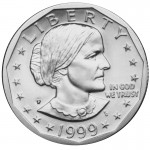
The Susan B. Anthony dollar coin was introduced in 1979 with much fanfare for being the first coin to honor a woman. The coin was a failure because it was confused with a quarter
Since the introduction of the Sacagawea dollar in 2000, the dollar coin’s size has remained the same but with the addition of manganese has a golden color to be visually different from other coins. For the visually impaired, the reeding was removed from the edges. Today, the Presidential $1 coins and the Native American $1 Coins have edge lettering that keeps it tactically different from the quarter dollar. However, people continue to bring up the Susan B. Anthony dollar as a reason not to use dollar coins.
Historically, dollar coins has been more popular in the western regions of the United States where the east prefers paper. Financial centers and big city government prefers paper for its alleged ease of handling. When circulated side-by-side, the public tends to choose paper over coin.
When we look around the world for examples of how to handle this situation, we find that the United States is the only country where the unit currency is available in both paper and coin. Other countries did not give people a choice. Rather, their governments made a decision based on overall economic benefits of using a coin with a predicted 30-year lifespan over paper currency that can last 18-24 months in circulation. Instead of the argument being of practical economics where every other country and the European Union have put on their proverbial long pants and made a decision that is in their best economic interest, factions in the United States comes up with mind boggling arguments of alleging that taking the paper dollar away is akin to taking away our freedom.
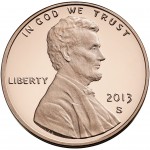
Obverse of the 2013-S Lincoln proof cent. Lincoln’s portrait, designed by Victor D. Brenner in 1909, is the longest running design of any United States coin.
The United States has a history of using its currency to boost the economic status of its citizens, aside from the various silver laws and the laws that eventually took the United States off the gold and silver standards, the creation of the half-cent was made because of the economic status of its citizens. Following Alexander Hamilton’s Treasury Secretrary’s report to congress “On the Establishment of a Mint,” Secretary of State Thomas Jefferson had another idea. Jefferson thought it would be better to tie subsidiary coins tied to the actual usage of the 8 reales coin. At the time, rather than worry about subsidiary coinage, people would cut the coin into pieces. A milled dollar cut in half was a half-dollar. That half-dollar cut in half was a quarter-dollar and the quarter-dollar cut in half was called a bit.
The bit was the basic unit of commerce since prices were based on the bit. Of course this was not a perfect solution. It was difficult to cut the quarter-dollars in half with great consistency which created problems when the bit was too small, called a short bit. Sometimes, short bits were supplemented with English pennies that were allowed to circulate in the colonies.
As an aside, this is where the nickname “two bits” for a quarter came from.
Jefferson felt that in order to convert the people from bit economy to a decimal economy, the half-cent was necessary to have 12½ cents be used instead of a bit without causing problems during conversion from allowing foreign currency to circulate as legal tender until the new Mint can produce enough coinage for commerce.
The half-cent would come into focus in the 1850s when the cost to produce the United State’s copper coins was nearly double their face value. In 1856, the Mint produced the first of the small cents, the Flying Eagle small cent, and produced 700 samples to convince congress to change to the small cent. As part of the discussion was the elimination of foreign currency from circulation making the U.S. Mint the sole supplier of coins.
There is no record of outcry from the public on the elimination of the half-cent. Its elimination came four years after the Coinage Act of 1853 that created the one-dollar and double eagle gold coins in response to the discovery of gold in North Carolina, Georgia, and California. The gold rush caused a prosperity and inflation that not only made the half-cent irrelevant but not something on the public’s mint. In that light, the Mint and congress felt that it just outlived its usefulness and would not be necessary with the elimination of foreign currency from circulation.
More controversy was generated in 1857 over the demonetizing foreign coins in the United States than the elimination of the half-cent. While the half-cent continued to circulate, it was estimated that one-third of the coins being circulated were foreign, primarily reales from Mexico. Redemption programs did not go smoothly, but in the end foreign coins were taken out of the market and the American people adapted and it could be said we prospered as a nation.
Like the 1850s, the last seven years have found that the cost of the copper used to make the one-cent coin has increased to more than the coin’s value. Combined with the labor and manufacturing costs, it costs the U.S. Mint between 1.6 and 1.8 cents for each copper-coated zinc cent struck. Although people argue that the cent is not needed and is barely useful, the U.S. Mint reports that 65-percent of its production are for one-cent coins that are ordered by the Federal Reserve to be circulated in commerce.
Eliminating the cent has caused controversy from those concerned with the economic welfare of the less fortunate. Many are using the same arguments that Jefferson made in 1791 to create the half-cent in order to keep the one-cent coin in circulation while others point to what other countries are doing. Canada is currently the country with the largest economy to eliminate its lowest denomination coin. Proponents of eliminating the cent point to Canada’s rocky success (withdrawal of the cent had been delayed twice) as an example of how the United States can handle the situation.
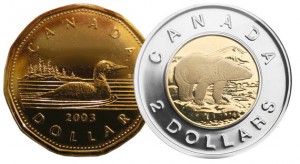
Canadian 1-dollar and 2-dollar coins. The 1-dollar coin is called a Loonie because its reverse depicts a common loon. “Toonie” is a play on the Loonie nickname.
Suggesting that if the United States follows Canada’s lead in the elimination of the cent, should the United States follow Canada’s lead and eliminate the one- and two-dollar Federal Reserve Notes in favor of one- and two-dollar coins?
This debate will continue until someone decides to act like an adult and make a definitive policy decision—especially when the Fed publishes a “working paper” that cherry picks facts to support a specific viewpoint.
Image of the Susan B. Anthony dollar and Lincoln cent courtesy of the U.S. Mint.
Image of the Canadian Loonie and Toonie courtesy of
Noticias Montreal.




 It is not a demographic issue as it is a commitment to the hobby’s future. I am sure the people at
It is not a demographic issue as it is a commitment to the hobby’s future. I am sure the people at 



 If you have not read “
If you have not read “

 According to a
According to a 















